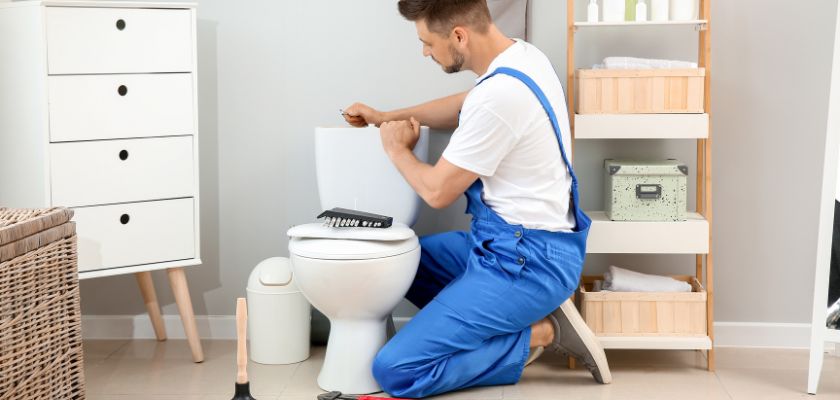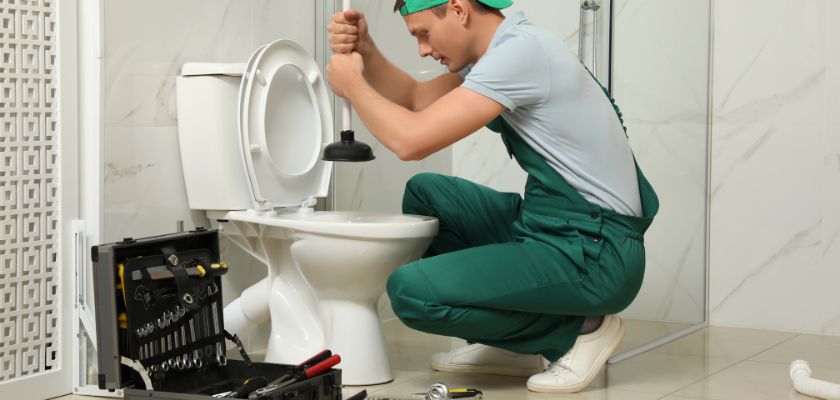Toilets are among the most essential fixtures in any home, yet they often become a source of frustration when things go wrong. Whether it’s a leak, a clog, or a malfunctioning flush, toilet problems can be both inconvenient and costly. However, many of these issues can be resolved with a bit of knowledge and some basic tools. In this guide, we will explore some of the most common toilet problems, the types of leaks you may encounter, and how to address these issues effectively. Additionally, for those living in specific areas like North Richland Hills, TX, we’ll discuss when it might be time to seek professional help for toilet repair.
Table Of Contents
Identifying and Fixing Common Toilet Problems

Running Toilet
Causes of a Running Toilet
A running toilet is one of the most common problems homeowners face. This issue occurs when water continuously flows from the tank into the bowl, even when the toilet is not in use. The sound of constantly running water can be annoying, but more importantly, it can waste a significant amount of water, leading to higher utility bills.
The primary cause of a running toilet is usually a faulty flapper valve. The flapper is a rubber seal at the bottom of the tank that controls the flow of water into the bowl. If the flapper is worn out, misaligned, or not sealing properly, water will continue to flow into the bowl. Other potential causes include a malfunctioning fill valve or an improperly adjusted float, which regulates the water level in the tank.
Fixing a Running Toilet
To fix a running toilet, start by checking the flapper valve. If it appears worn or damaged, replace it with a new one. Flapper valves are inexpensive and readily available at most hardware stores. If the flapper seems fine, inspect the fill valve and the float. Adjust the float to ensure the water level is correct, and if the fill valve is faulty, consider replacing it.
If these fixes do not stop the running, you might have a more complex issue that requires professional attention. In such cases, seeking toilet repair in North Richland Hills, TX can ensure that the problem is diagnosed and resolved effectively.
Clogged Toilet
Causes of a Clogged Toilet
A clogged toilet is another common issue that can cause significant inconvenience. Clogs typically occur when something blocks the flow of water through the toilet drain. This can be due to flushing inappropriate items like wipes, feminine hygiene products, or too much toilet paper. In some cases, the clog may be deeper in the plumbing system, caused by tree roots or buildup in the pipes.
The severity of the clog can vary. A partial clog may cause slow draining and weak flushing, while a complete clog can result in an overflow, creating a messy and unsanitary situation.
Fixing a Clogged Toilet
The first step in fixing a clogged toilet is to try using a plunger. A plunger creates suction and pressure that can often dislodge the blockage. Be sure to use a toilet plunger with a flange, as this design is more effective for clearing toilet clogs. Place the plunger over the drain hole and push down firmly, then pull up sharply. Repeat this process several times.
If the plunger doesn’t work, you may need to use a toilet auger, also known as a plumber’s snake. This tool can reach deeper into the toilet drain to break up or pull out the blockage. Insert the auger into the drain and turn the handle clockwise to work it through the clog.
If these methods fail to clear the clog, the problem may be further down the plumbing system, and professional toilet repair in North Richland Hills, TX may be necessary. A plumber can use advanced tools to locate and remove the blockage without damaging your plumbing.
Leaking Toilet
Types of Leaks
Toilet leaks are a common problem that can lead to water waste and damage to your bathroom floor. Understanding the types of leaks that can occur in a toilet is essential for diagnosing and fixing the issue. The most common types of toilet leaks include:
- Tank to Bowl Leaks: These leaks occur between the toilet tank and the bowl, often caused by a worn-out gasket or loose bolts. Water may seep from the tank into the bowl or onto the floor.
- Base Leaks: If you notice water pooling around the base of your toilet, it’s likely due to a damaged wax ring or a loose toilet flange. These leaks can damage the flooring and subfloor if not addressed quickly.
- Silent Leaks: These leaks are harder to detect because there is no visible water. They occur when water slowly leaks from the tank into the bowl due to a faulty flapper valve or a crack in the tank.
Fixing Toilet Leaks
To fix a leaking toilet, you first need to identify the source of the leak. For tank-to-bowl leaks, start by tightening the tank bolts. If the leak persists, replace the gasket that seals the connection between the tank and the bowl.
For leaks at the base of the toilet, the most likely culprit is the wax ring that seals the toilet to the floor. Replacing the wax ring involves removing the toilet, cleaning the flange, and installing a new ring before reseating the toilet. This can be a challenging task, so if you’re not comfortable doing it yourself, it’s best to hire a professional for toilet repair in North Richland Hills, TX.
Silent leaks can be detected by adding a few drops of food coloring to the tank and waiting for 15-30 minutes without flushing. If the color appears in the bowl, you have a silent leak. Replacing the flapper valve usually solves this problem.
Preventing Toilet Problems

Regular Maintenance
Inspecting Toilet Components
Regular maintenance is key to preventing common toilet problems. Periodically inspect the components inside your toilet tank, including the flapper valve, fill valve, and float. These parts can wear out over time, leading to issues like running toilets or leaks. Replacing them as needed can help keep your toilet functioning properly.
It’s also a good idea to check for signs of leaks regularly. Look for water pooling around the base of the toilet or stains on the floor that might indicate a slow leak. Early detection of leaks can prevent costly damage to your bathroom.
Cleaning the Toilet
Keeping your toilet clean is not only important for hygiene but also for preventing problems. Regularly clean the toilet bowl, tank, and components to remove mineral buildup and prevent clogs. Avoid using harsh chemicals that can damage the toilet’s internal parts. Instead, opt for mild cleaners or a vinegar solution.
Cleaning the toilet tank every six months can help prevent sediment buildup that can clog the fill valve or cause other issues. Simply turn off the water supply, flush the toilet to empty the tank, and scrub the inside with a brush and a vinegar-water solution.
Professional Installation
The Importance of Professional Installation
While many toilet problems can be fixed with DIY methods, proper installation is crucial to preventing issues in the first place. A leak-free toilet installation ensures that all components are correctly aligned, sealed, and secured, reducing the risk of leaks, clogs, and other problems.
For homeowners in North Richland Hills, TX, professional installation is particularly important due to local plumbing codes and environmental factors that can affect toilet performance. Hiring a professional for toilet repair in North Richland Hills, TX, or for new installations ensures that the job is done right and in compliance with local regulations.
Long-Term Benefits of Professional Installation
Investing in professional installation offers long-term benefits. A properly installed toilet is less likely to experience issues like leaks, weak flushing, or instability. It also ensures that the toilet is installed according to manufacturer specifications, which is important for maintaining warranties and ensuring optimal performance.
Moreover, professional installation provides peace of mind. If any problems arise after installation, a reputable plumber will stand by their work and address the issue without additional cost to you. This level of service is particularly valuable in ensuring the longevity and reliability of your toilet.
When to Call a Professional

Recognizing Complex Issues
While many toilet problems can be resolved with basic tools and knowledge, some issues require the expertise of a professional plumber. If you’ve attempted to fix a problem yourself but it persists, or if you’re dealing with more complex issues like a broken flange, cracked toilet base, or persistent leaks, it’s time to call a professional.
Additionally, if you’re installing a new toilet and want to ensure a leak-free toilet installation, hiring a professional is strongly recommended. This ensures that the toilet is installed correctly, preventing future problems and ensuring compliance with local plumbing codes.
Choosing the Right Plumber
When choosing a plumber for toilet repair in North Richland Hills, TX, it’s important to select someone with experience, good reviews, and proper licensing. A reputable plumber will accurately diagnose the issue, provide a fair estimate, and complete the work efficiently.
Look for plumbers who offer warranties on their work and are transparent about their pricing. This ensures that you’re getting quality service and that any issues that arise after the work is completed will be handled without additional cost to you.
Final Wording
Toilet problems are a common occurrence in any household, but with the right knowledge and tools, many of these issues can be resolved quickly and effectively. From running toilets and clogs to various types of leaks, understanding how to diagnose and fix these problems is essential for any homeowner. Regular maintenance and proper installation can prevent many of these issues from occurring in the first place.
For those in North Richland Hills, TX, seeking professional toilet repair or installation services ensures that your toilet remains in top condition, providing peace of mind and long-term reliability. By addressing toilet problems promptly and investing in quality repairs and installations, you can maintain a functional and efficient bathroom for years to come.
FAQ’s
1. What are the most common types of leaks in a toilet, and how can I identify them?
The most common types of leaks include tank-to-bowl leaks, base leaks, and silent leaks. Tank-to-bowl leaks can be identified by water seeping between the tank and bowl, base leaks show as water pooling around the toilet base, and silent leaks can be detected by adding food coloring to the tank and checking if it seeps into the bowl without flushing.
2. Why is my toilet constantly running, and how can I fix it?
A constantly running toilet is usually caused by a faulty flapper valve, a malfunctioning fill valve, or an improperly adjusted float. Fix it by replacing the flapper or fill valve and adjusting the float to the correct water level.
3. How can I prevent toilet clogs from happening frequently?
To prevent clogs, avoid flushing inappropriate items like wipes, feminine hygiene products, or excessive toilet paper. Regularly cleaning the toilet and using an appropriate amount of toilet paper can also help maintain proper drainage.
4. When should I consider hiring a professional for toilet repair in North Richland Hills, TX?
Consider hiring a professional for toilet repair in North Richland Hills, TX, when dealing with persistent leaks, complex clogs, broken flanges, or if you’re unsure about handling a repair yourself. Professional help ensures the problem is correctly diagnosed and fixed.
5. What are the benefits of a leak-free toilet installation?
A leak-free toilet installation prevents water damage, ensures stability, and reduces the likelihood of future issues like weak flushing or persistent leaks. It also guarantees that the toilet is installed according to local plumbing codes.



